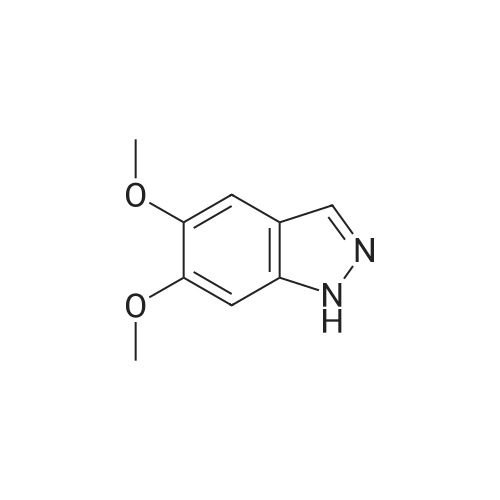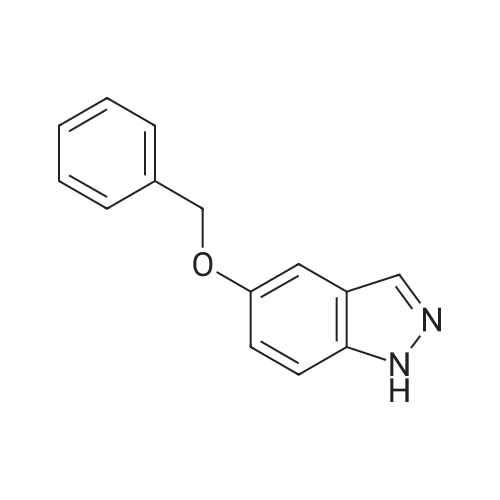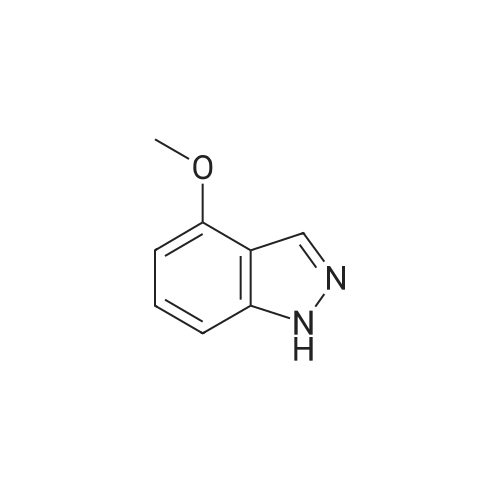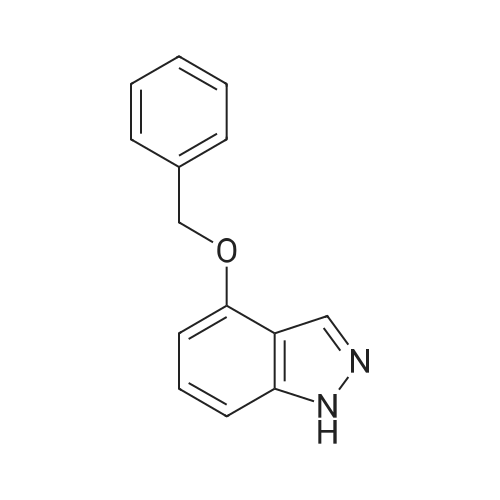| 59% |
In ethyl acetate; at 20℃; for 3h; |
To a solution of 5-methoxy-indazole (1.0 g, 6.7 mmol) in ethyl acetate (10 ml) was added BF40(CH3)3(1.3 g, 8.9 mmol). The solution was stirred at rt for 3 h. Sat. NaHC03aq. (10 ml) was added and extracted with ethyl acetate (20 ml). Organics were dried over Na2S04, concentrated, and purified by flash chromatography on silica gel (PE /EA = 2/1) to afford 0.64 g (59%) of the title compound as a yellow solid. [M+H] Calc'd for C9H10N2O, 163; Found, 163. |
|
In ethyl acetate; at 20℃; for 2h; |
2-methyl-4-methoxyphenylamine (27.4 g, 200 mmol) was added to a solution of tetrafluoroboric acid (HBF4, 50% aqueous solution, 100 mL). The solution was stirred at room temperature for about 10 min, then cooled to 0~5C. A solution of sodium nitrite (13.9 g, 200 mmol) in water (20 mL) was dropped in. The mixture was warmed to room temperature and stirred 1 h. The reaction mixture was filtrated and the crude product was washed with diethyl ether (3 x 100 mL) and dried in air to provided 49.7 g of 2-methyl-4-methoxyphenyldiazonium tetrafluoroborate. 2-methyl-4-methoxyphenyldiazonium tetrafluoroborate (49.7 g, 21 1 mmol), 18-crown-6 (2.79 g, 10.6 mmol), potassium acetate (43.4 g, 422 mmol) were added to chloroform (300 mL). The reaction mixture was stirred at room temperature for 2 h. The solution was washed with brine (3 x 30 mL), dried over sodium sulphate, and the solvents evaporated under vacuum. The residue was purified by flash chromatography (ethyl acetate/petroleum ether 2:8 to 4:6) to provide 5-methoxy- lH-indazole (10.2 g). LC-MS (ESI) M+lfound= 149 (MWcalc= 148.1) To a stirred mixture of 5-methoxy-lH-indazole (9.5 g, 64.6 mmol) in ethyl acetate (200 mL), was added trimethyloxonium tetrafluoroborate (19.1 g, 129 mmol). The mixture was stirred at room temperature for 2 h. The reaction mixture was washed with saturated NaHCO3 solution (100 mL). The organic layer was separated and the aqueous layer was extracted with ethyl acetate (2 x 100 mL). The combined organic layers were dried over anhydrous sodium sulphate, filtered and the solvents evaporated. Purification of the residue by flash chromatography (ethyl acetate/petroleum ether 2:3) gave 5-methoxy-2-methyl-2H-indazole (8.6 g). LC-MS (ESI) M+lfound= 163 (MWca,c= 162.1).To a mixture of 5-methoxy-2-methyl-2H-indazole (8.2 g, 50.6 mmol) in acetic acid (100 mL) was added N-bromosuccinimide (9.01 g, 50.6 mmol). The mixture was stirred at room temperature for 4 h. The reaction was quenched with ethyl acetate (200 mL) and washed with saturated NaHCO3 aqueous solution until stopped bubbling. The organic layer was separated and washed with brine, then dried over anhydrous sodium sulphate, filtered and concentrated under vacuum. Purification of the residue by flash chromatography (ethyl acetate/petroleum ether 1 :9) gave 3-bromo-5-methoxy- 2-methyl-2H-indazole (8.23 g). LC-MS (ESI) Mfound= 241 (MWcalc= 241.1) 3-Bromo-5-methoxy-2-methyl-2H-indazole (7.9 g, 32.7 mmol) was dissolved in dimethylacetamide (200 mL), and the following reagents were added: Pd2(dba)3 (1.2 g, 1.3 mmol, 4 mol%), Dppf (1.4 g, 2.6 mmol, 8 mol%), Zn powder (513 mg, 7.8 mmol, 24 mol%) and Zn(CN)2 (4.6 g, 39.2 mmol). The mixture was stirred at 170C for 6 h. The reaction mixture was quenched with water (400 mL) and extracted with ethyl acetate (3 x 200 mL). The organic extracts were dried over sodium sulphate and concentrated in vacuum. The crude product was purified by flash chromatography (ethyl acetate/petroleum ether 2:8) to give 5-methoxy-2-methyl-2H-indazole-3-carbonitrile as a white solid (5.9 g).5-Methoxy-2-methyl-2H-indazole-3-carbonitrile (4.67 g, 25 mmol) was dissolved in methanol (60 mL) and an aqueous solution of sodium hydroxide (10%, 60 mL) was added. The reaction mixture was refluxed for 4 h. Methanol was evaporated in vacuum. The residue was acidified to pH=4~5 EPO <DP n="72"/>and extracted with ethyl acetate (3 x 100 mL). The combined organic layers were washed with brine, dried and evaporated to provide 5-methoxy-2-methyl-2H-indazole-3-carboxylic acid (4.3 g) as a white powder.To a dichloromethane (400 mL) solution of 5-methoxy-2-methyl-2H-indazole-3-carboxylic acid (4.3 g, 20.6 mmol) were added methy lam ine (hydrochloride salt, 2.8 g, 41.3 mmol), 1- hydroxybenzotriazole hydrate (HOBt) (5.6 g, 41.3 mmol), 3-ethyl-l-[3-(dimethylamino)propyl]carbodiimide hydrochloride (EDCI) (11.9 g, 62 mmol) and triethylamine (17 mL, 124 mmol). The reaction mixture was stirred at room temperature for 3 h and then quenched with water (200 mL). The organic layer was separated and the aqueous layer was extracted with dichloromethane (2 x 100 mL). The combined organic layers were washed with diluted hydrochloric acid and brine, dried and evaporated to provide 5-methoxy-2-methyl-2H- indazole-3-carboxylic acid methylamide (3.03 g). LC-MS (ESI) Mfound= 219 (MWcalc= 219.2) To a solution of 5-methoxy-2-methyl-2H-indazole-3-carboxylic acid methylamide (2.9 g, 13.1 mmol) in dry dichloromethane (150 mL), Boron trifluoride-methyl sulfide complex (IM, 35 mL) was dropped in at O0C and the reaction mixture was warmed to room temperature and stirred overnight. The reaction was quenched with water, the water phase was extracted with dichloromethane (3 x 50 mL), and the combined organic phases were washed with brine, dried over sodium sulphate, and concentrated under vacuum to provide 5-hydroxy-2-methyl-2H-indazole-3- carboxylic acid methylamide (2.7 g). Yield from 2-methyl-4-methoxyphenylamine: 10%To a soluti... |

 Chemistry
Chemistry
 Pharmaceutical Intermediates
Pharmaceutical Intermediates
 Inhibitors/Agonists
Inhibitors/Agonists
 Material Science
Material Science















 For Research Only
For Research Only
 120K+ Compounds
120K+ Compounds
 Competitive Price
Competitive Price
 1-2 Day Shipping
1-2 Day Shipping













